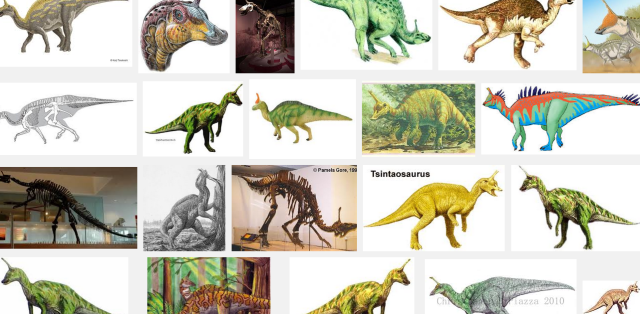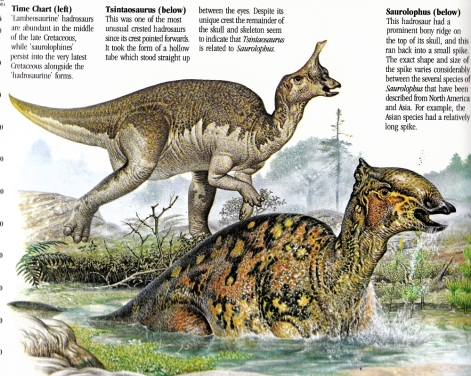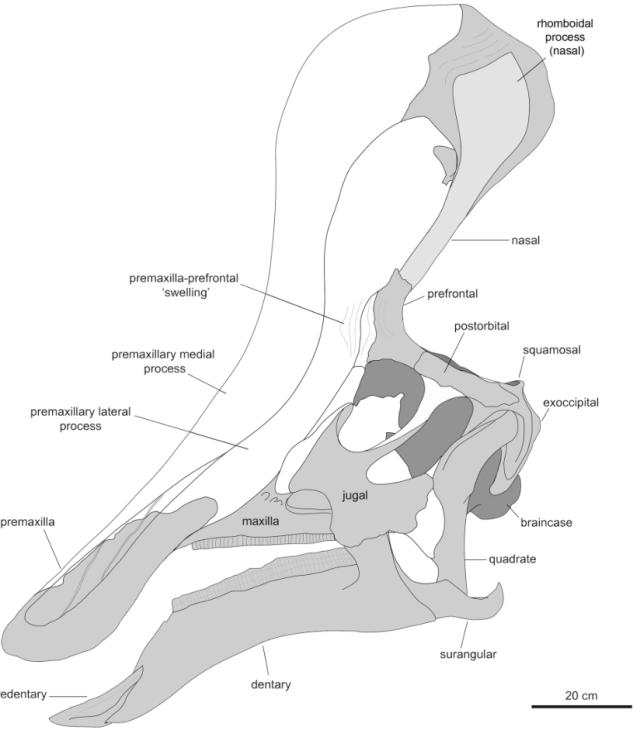Tsintaosaurus spinorhinus [n1] is infamously known as the “unicorn” of hadrosaurs, a lambeosaurine (tsintaosaurin, from Tsintaosaurini) hadrosaurid with a single elongated, solid bony spike protruding from its forehead. The skull was never complete, but it wouldn’t matter, as the diversity of hadorsaur crests implied that such a spike was “plausible,” and artists ran with it. Here’s a sampling, from Google’s image search:

First page of results from Google’s image search function for “Tsingtaosaurus” reveals that virtually all reconstructions of the dinosaur were with a single, natural spike on its head.
But the reconstruction was always based on speculation: It was known for some time that the “spike” was but a remnant of the actual crest, not merely all of it, as the premaxillae were missing above the snout, there was but a sliver of prefrontal present, and despite seeming to be lambeosaurine the spike itself — composed of nearly complete but vertically-oriented nasals — was “solid.” Weishampel & Horner (1990) argued that because of the latter, the hadrosaur was a saurolophine, with their simple crests, and others suggested that the crest was taphonomically distorted, rotated up from its natural position (Taquet, 1991). Regardless of this, the popular image of Tsintaosaurus was as “the unicorn dinosaur” and this imagery, helped in large part by the rather salacious-looking rendering given it by John Sibbick in The Illustrated Encyclopedia of Dinosaurs:

Sibbick’s illustration of Tsintaosaurus spinorhinus on the same page with Saurolophus osborni facing the lambeosaurines on the other page followed Weishampel’s allusion that the spike was all that there was. It is further unfortunate that it helped promote a trend in reconstruction of a pair of large … erm … balls at the base of the … uh … rod, and thus earning the title of the “dickhead” dinosaur.
Speculation notwithstanding, Tsintaosaurus spinorhinus has a wonderfully preserved skull. It’s just that one small section of it is missing, but that section is a fantastically important one, as it contains the possible looping nasal passage from the enclosing premaxillae. The bone, once considered tube-like (Yang, 1958) but not due to serious investigation, was seemingly solid. Enter Albert Prieto-Márquez and Jonathan Wagner, who have made some effort together of puzzling out a strange, Eurasian-only branch of lambeosaurines, the Tsintaosaurini. In examining not just the holotype skull, but the paratype skull, which is even less complete than the type, and associated material that was initially rejected by Yang for pertinence, Prieto-Márquez and Wagner assumed that the premaxillae were not only far more extensive, but like other hadrosaurids would have comprised an extensive and elaborate crest due to the needs to match up evolutionarily with lambeosaurine diversity. Many regions of the skull suggest that the tsintaosaurin skull design would have arisen after the development of a large, looping nasal passage within the crest, so that the loop would have been present before the unusual and distinct forward-projecting nasals developed, which merely elaborated on the crest design. Prieto-Márquez & Wagner (2013) do actually suggest that Taquet (1991) was correct in part, in that the crest was misaligned, but rather than laying flat against the skull, they’ve rotated it further caudally, and have made the crest normalized in appearance:

Reconstruction of the skull of Tsintaosaurus spinorhinus Yang (1958), from Prieto-Marquez & Wagner (2013). The tip of nasals are caped by a fragment of the premaxilla which has been initially regarded by Yang as indeterminate hadrosaurian crest fragment, and not considered since, but appears to be a portion of the “hook-like” premaxillary terminus at its contact with the nasals. Reconstruction from Prieto-Márquez & Wagner (2013).
If anything, this skull design resembles the peculiar large lambeosaurine from East Asia, Olorotitan arharensis (Godefroit et al., 2003; a rendering here by Andrey Atuchin clearly underlines this similarity), and suggests some normalcy was retained for virtually all lambeosaurine crests, even when given the same effective nascent morphology (see Farke et al., 2013, on Parasaurolophus ontogeny).
I admit to having talked to Jon Wagner about this way back in 2001. Much speculation arose then but little has been published on it since. But the product of that discussion, including the realization that the crests of virtually all lambeosaurines follow the same basic semi-circular design prompted a reconstruction by me that I originally produced to send off to Prehistoric Times that year as part of a call for art. I took this time to make sure I could actually render the skull correctly, and then form a crest from it that seemed plausible. This was based solely on the assumption — and no furtehr details from anyone — that the nasals were but a fragment of the crest itself, providing the back edge of the whole affair. Thus:

A cranila and flesh reconstruction for Tsintaosaurus spinorhinus as a non-dickhead-headed hadrosaur. The details of the skull, including relative size of the maxilla and premaxilla, are completely off, and I regret the error.
These new reconstructions allow us to re-evaluate what we thought we knew about some dinosaurs; that there are classic models for their appearance that are either simply wrong (such as the spike-tailed Scolosaurus) or just a tad off. This is how science moves on. And it is nice to know that, after 10 years, a reconstruction that began as a concept sketch (the skull seen above) from a half-remembered conversation at SVP would turn out to be pretty close to the probable appearance of the animal’s skull, and thus its life-appearance.
[n1] The name is derived from the city of Qingdao in the county of the same name in the Chinese Province of Shandong, from whence the specimens derived. However, during collection of the material in the 1930s, the region was within the Republic of China, during which time written language and pronunciation often varied and thus the ligatures would often differ from implied pronunciation. In this time, when Ryabinin (1939) proposed the name, the city was called Tsingtao, or alternately Tsintao, and Ryabinin opted for the second option: lizard of Tsin[g]tao. Modern pronunciation — and to a degree that during the time the name was coined — uses Qingdao (or alternately, Qindao) — following the Hànyǔ pīnyīn convention for transliteration. The pronunciation is chin[g]-dow-SAWR-ohs; “g” is lightly pronounced, more a suggestion than a hard “g.” However, the absence of the “g” in the formal name of the taxon leads to some confusion. The initial release of this post included use of the name “Tsintaosaurus” with the superlative “g,” and none without, but have been artfully edited out of existence.
Farke, A. A., Chok, D. J., Herrero, A., Scolieri, B. & Werning, S. 2013. Ontogeny in the tube-crested dinosaur Parasaurolophus (Hadrosauridae) and heterochrony in hadrosaurids. PeerJ 1: e182.
Godefroit, P., Bolotsky, Y. & Alifanov, V. 2003. A remarkable hollow-crested hadrosaur from Russia: an Asian origin for lambeosaurines. Comptes Rendus Palevol 2 (2): 143–151.
Prieto-Márquez, A. & Wagner, J. R. 2013. The “unicorn” dinosaur that wasn’t: A new reconstruction of the crest of Tsintaosaurus and the early evolution of the lambeosaurine crest and rostrum. PLoS ONE 8 (11): e82268.
Taquet, P. 1991. The status of Tsintaosaurus spinorhinus Young, 1958 (Dinosauria). pp.63-64 in Kielan-Jaworowska, Heint & Nakrem (eds.) Fifth Symposium of Mesozoic Terrestrial Ecosystems and Biota. Contributions from the Paleontological Museum, Oslo.
Weishampel, D. B. & Horner, J. R. 1990. Hadrosauridae. pp.534-561 in Weishampel, Dodson & Osmólska (eds.) The Dinosauria. University of California Press, Berkeley.
Yang Z-z. (Young, C. C.) 1958. The dinosaurian remains of Laiyang, Shantung. Palaeontologia Sinica 142: 53-159.



I like this line of thought. Anomalies are often mistakes.
Well, looking at it logically from the very beginning would have produced a similar result. But this is advanced thinking: The logic that I employ and that Prieto-Márquez and Wagner employ when it comes to constraints on shape are merely observations from the multitude of taxa: The premaxillae in Lambeosaurinae are always seemingly rostro-dorsally bowed, from Parasaurolophus to this taxon. But Tsingtaosaurus is still an outlier: The crest structure is still very distinct: The frontal platform is expanded into a forward projecting process that inflects the basal of the nasal rostrally (hence the reconstruction pointing forward) but then curves caudally. Instead of being short and embedded within the premaxillae as in other lambeosaurines, the nasal is visible from behind, and suggests that basal lambeosaurines with crests would have also visible crests. Thus, it implies the reconstruction is nascent to “typical” lambeosaurines. All, because of logic.
Glad to see Tsintaosaurus with a more rounded, full-fledged crest… Even if, as many, i’ve always taken the unicorn-look as plausible (considering, as you said, the wide array of head gear in hadrosaurs), there was something definitely “off” about it.
First Deinocheirus, then Tsintaosaurus, i wonder what will be the next discovery that will change our view of these beasts…
We shall have to wait and see what’s to come.
Who would have though that what you have drawn way back in 2001 as a hypothetical (if not a somewhat heretical) idea about how Tsintaosaurus looked like would turn out to be startlingly very close to its real life appearance 12 years later. If you made this claim back in 2001, many might have teased you for your imagination. Cheers for rendering the animal with an incandescent bulb-like crest. It looks very exquisite!
Well, Jon Wagner would have thought. Bear in mind that, as I say in the article, I discussed this topic with him back when he was preparing this research. He shared some of these ideas with me. I revisited them in a half-fog, but I think I was faithful to the idea, and rendered the skull with a more “conventional” shape a la Lambeosaurinae in order to make “sense” of Tsintaosaurus. Initially, I never showed this illustration because the skull was weakly drawn (there are proportion errors in it involved) and because I lacked good reference to Ryabinin’s work. (I will admit the idea was a bit of a tease back then, not one which many people necessarily agreed upon: the view was always that Tsintaosaurus spinorinus was spike-crested and saurolophine.)
Pingback: Tsintaosaurus, Unicorn No More – Phenomena: Laelaps
Tis a pity, but the phallic look did seem inconsistent with the normal lambeosaurine head casque look.
Pingback: Morsels For The Mind – 29/11/2013 › Six Incredible Things Before Breakfast
Pingback: A Look Back at the Bite Stuff, 2013 Edition | The Bite Stuff
Pingback: Tsintaosaurus’ Horn Moved Back and Forth | Coffee and Creatures